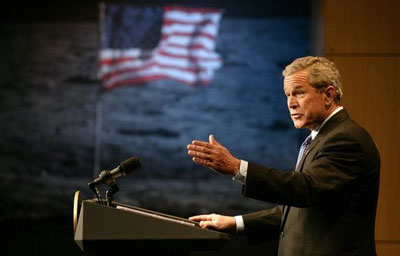The US election and the future of the solar systemby Taylor Dinerman
|
| What the election may decide is when and how this movement off the Earth will take place, and who will lead it. |
Towards the end of 2001, Goldin finally left and Sean O’Keefe was nominated and confirmed as NASA administrator. The agency’s new chief was a management expert who seemed to lack any deep enthusiasm for NASA’s traditional exploration goals. Indeed, his early efforts at reforming the agency could have been aimed at any large government bureaucracy. He started to try and fix the accounting system (it is almost certain that, if we do get to Mars by 2050, NASA will still be having these problems) and tried to get a handle on out-of-control project costs. This could have been done at the Coast Guard, the Department of Agriculture, or any other medium to large size bureaucracy: a good and necessary effort, but not one that promised any great leaps of imagination.
Gradually, O’Keefe and the administration came to certain conclusions about NASA, and about the future. In November 2002, the Walker Commission, which examined the future of the US aerospace industry, pointed out that, “for nearly two decades, we have been satisfied to limit our dreams, rely on proven technology, and invest little in building public or political support for space initiatives.” For the administration, this was not good enough. While the commission recommended that the focus be on power and propulsion, they also urged that the US create a “Space Imperative.”
On February 1, 2003, the shuttle Columbia disintegrated on re-entry. Suddenly, the US was faced with an urgent need to completely rethink the whole of its space policy. The story of what happened is ably described by Frank Sietzen and Keith Cowing in their book New Moon Rising. (See “Review: New Moon Rising”, The Space Review, August 2, 2004) The Vision for Space Exploration, which President Bush put forward last winter, was the product of some careful political, technological, and economic calculations. It has stood up to the usual critics’ barrage, and its essential soundness remains, provided that one wants to see humans explore the solar system.
Retiring the shuttle after the completion of the ISS, and retiring the ISS itself, or at least disengaging the US from any major role in it after 2015, is the key to making the whole project “sustainable and affordable.” The mass of funds thus liberated can then be used to pay for the return to the Moon, and for the eventual voyage to Mars. The administration is asking for some modest increases in total NASA spending to jumpstart this project. While they may be having some trouble with Congress now, it is encouraging that most interested members, Democrats as well as Republicans, have accepted the goals of the vision, if not the details. Indeed, the President’s vision was more or less what many Democrats, such as Congressman Nick Lampson, had long been calling for.
| The details of the Vision for Space Exploration may be less important than the fact that the US now has space exploration as a major national goal. The implication here is that we will someday reach the Moon and Mars and that we will not stop with simple exploration. |
In the last four years, the effort to lower the overall costs of access to space has, it seems, failed. Neither the X-33 nor NASA’s other efforts to reduce launch costs by developing a new generation of launch vehicles came to fruition. NASA and the Defense Department have decided to put these programs on the back burner. Fortunately, there are a number of entrepreneurs out there who are taking up the challenge. While they have far less money available, they are making up for it with guts, ingenuity and brainpower. The success of SpaceShipOne and the Ansari X Prize show what the private sector can do when given the chance.
The details of the Vision for Space Exploration may be less important than the fact that the US now has space exploration as a major national goal. The implication here is that we will someday reach the Moon and Mars and that we will not stop with simple exploration. The technology needed to build bases on the Moon and Mars could also be used to build sustainable permanent colonies on these bodies. Once built, such colonies will be the first steps towards our species expansion into the solar system.
One can legitimately debate whether problems such as overpopulation, pollution, sustainable development, and resource depletion can be partly, or wholly, solved by the development and colonization of the solar system. It is also obvious that the human race has too many ambitious, visionary, and restless members to be stuck on one planet forever. The Vision for Space Exploration provides a realistic pathway for America to lead humanity off the planet and into this great adventure. As the Columbia disaster demonstrated, this is a dangerous, as well as difficult, journey, but as Ronald Reagan said, “…we are too great a nation to limit ourselves to small dreams.”
With the reelection of George W. Bush, America will begin this journey. Other presidents, of both parties, will continue it. Major elections have never been decided one way or another on space issues, yet, in spite of what has been called, “The Myth of Presidential Leadership,” they sometimes offer a real choice. George W. Bush has shown that he has both the vision and the will to lead this country towards the stars—for Americans, there is no worthier goal.
